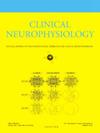手部固定72小时后的力量下降是由神经驱动受损引起的,而肌肉收缩性没有改变。
IF 3.6
3区 医学
Q1 CLINICAL NEUROLOGY
引用次数: 0
摘要
目的:尽管长期固定对肌肉功能的影响已有文献记载,但短期停用的神经肌肉后果,特别是上肢,仍然知之甚少。本研究探讨了72小时手部固定对肌肉力量的影响及其潜在的神经肌肉机制。方法:28名参与者被分配到固定组(n = 14)和对照组(n = 14),固定组接受72小时的手部固定,然后进行7天的恢复期。最大自主收缩、自主激活、第一背骨间肌电图活动和电诱发收缩特性分别在固定前、固定后和固定后7天进行评估。结果:固定导致肌肉力量明显下降,这种情况持续一周后恢复。力量下降伴随着自主活动和肌电活动的显著减少,而肌肉的收缩特性保持不变。结论:研究结果表明,短期上肢固定会导致快速和持续的力量丧失,主要是由神经驱动减弱而不是肌肉收缩力的改变引起的。意义:研究结果强调了在短时间内保持神经功能的重要性,并强调了短期上肢固定方案在研究力量丧失的主要机制方面的实用性。本文章由计算机程序翻译,如有差异,请以英文原文为准。
Strength decline after 72 h of hand immobilization is driven by impaired neural drive with no alterations in muscle contractility
Objective
Although the effects of long-term immobilization on muscle function are well documented, the neuromuscular consequences of short-term disuse, particularly in the upper limbs, remain poorly understood. This study investigated the impact of 72 h of hand immobilization on muscle strength and the underlying neuromuscular mechanisms.
Methods
Twenty-eight participants were assigned to either an immobilization group (n = 14), who underwent 72 h of and hand immobilization followed by a 7-day recovery period, or a control group (n = 14). Maximal voluntary contraction, voluntary activation, first dorsal interosseous electromyographic activity, and electrically evoked contractile properties were assessed before, immediately after, and seven days post-immobilization.
Results
Immobilization resulted in significant reductions in muscle strength, which persisted after one week of recovery. The strength decline was accompanied by significant reductions in voluntary activation and electromyographic activity, whereas the contractile properties of the muscles remained unchanged.
Conclusions
The findings demonstrate that short-term upper-limb immobilization induces rapid and sustained strength loss, primarily driven by diminished neural drive rather than alterations in muscle contractility.
Significance
The results emphasize the importance of preserving neural function during brief periods of disuse and highlight the utility of short-term upper-limb immobilization protocols for studying the central mechanisms of strength loss.
求助全文
通过发布文献求助,成功后即可免费获取论文全文。
去求助
来源期刊

Clinical Neurophysiology
医学-临床神经学
CiteScore
8.70
自引率
6.40%
发文量
932
审稿时长
59 days
期刊介绍:
As of January 1999, The journal Electroencephalography and Clinical Neurophysiology, and its two sections Electromyography and Motor Control and Evoked Potentials have amalgamated to become this journal - Clinical Neurophysiology.
Clinical Neurophysiology is the official journal of the International Federation of Clinical Neurophysiology, the Brazilian Society of Clinical Neurophysiology, the Czech Society of Clinical Neurophysiology, the Italian Clinical Neurophysiology Society and the International Society of Intraoperative Neurophysiology.The journal is dedicated to fostering research and disseminating information on all aspects of both normal and abnormal functioning of the nervous system. The key aim of the publication is to disseminate scholarly reports on the pathophysiology underlying diseases of the central and peripheral nervous system of human patients. Clinical trials that use neurophysiological measures to document change are encouraged, as are manuscripts reporting data on integrated neuroimaging of central nervous function including, but not limited to, functional MRI, MEG, EEG, PET and other neuroimaging modalities.
 求助内容:
求助内容: 应助结果提醒方式:
应助结果提醒方式:


